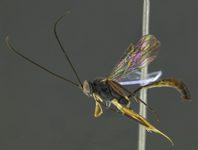Abstract
Modern taxonomy and systematics profit from an invaluable tool that has been developed in the course of more than a century by intense discussions and negotiations of generations of zoologists and palaeontologists: The International Code of Zoological Nomenclature (ICZN 1999, 2012). The main goal of the Code is “to promote stability and universality in the scientific names of animals and to ensure that the name of each taxon is unique and distinct” (Melville 1995, ICZN 1999: 2). The provisions of the Code are generally accepted and thoroughly applied by the scientific community. Exceptions, such as the one described below, are very rare.
References
Bacher, S. (2012) Still not enough taxonomists. Trends in Ecology and Evolution, 27, 65–66.
https://doi.org/10.1016/j.tree.2011.11.003
Barnosky, A.D., Matzke, N., Tomiya, S., Wogan, G.O.U., Swartz, B., Quental, T.B., Marshall, C., McGuire, J.L., Lindsey, E.L., Maguire, K.C., Mersey, B. & Ferrer, E.A. (2011) Has the earth’s sixth mass extinction already arrived? Nature, 471, 51–57.
https://doi.org/10.1038/nature09678
Baur, H., Kranz-Baltensperger, Y., Cruaud, A., Rasplus, J.-Y., Timokhov, A.V. & Gokhman, V.E. (2014) Morphometric analysis and taxonomic revision of Anisopteromalus Ruschka (Hymenoptera: Chalcidoidea: Pteromalidae) — an integrative approach. Systematic Entomology, 39, 691–709.
https://doi.org/10.1111/syen.12081
Baur, H. & Leuenberger, C. (2011) Analysis of ratios in multivariate morphometry. Systematic Biology, 60, 813–825.
https://doi.org/10.1093/sysbio/syr061
Coleman, C.O. (2006) Substituting time-consuming pencil drawings in arthropod taxonomy using stacks of digital photographs. Zootaxa, 1360, 61–68.
ICZN [International Commission on Zoological Nomenclature] (1999) International Code of Zoological Nomenclature. Fourth edition. International Trust for Zoological Nomenclature, London, 126 pp.
ICZN (2012) International Code of Zoological Nomenclature. 4th Edition. [Incorporating Declaration 44, amendments of Article 74.7.3, with effect from 31 December 1999 and the Amendment on e-publication, amendments to Articles 8, 9, 10, 21 and 78, with effect from 1 January 2012]. Available from: http://www.nhm.ac.uk/hosted-sites/iczn/code (accessed 31 May 2018)
Jäger, P. (2016) A plea for taxonomic drawings and against pure photo-taxonomy. Indian Journal of Arachnology, 5 (1–2), 61–66.
Maddison, W.P. (2015) A phylogenetic classification of jumping spiders (Araneae: Salticidae). Journal of Arachnology, 43, 231–292.
https://doi.org/10.1636/arac-43-03-231-292
Maddison, W.P. & Hedin, M.C. (2003) Jumping spider phylogeny (Araneae: Salticidae). Invertebrate Systematics, 17, 529–549.
https://doi.org/10.1071/IS02044
Melville, R.V. (1995) Towards stability in the names of animals. A history of the International Commission on Zoological Nomenclature 1895–1995. International Trust of Zoological Nomenclature, London, 92 pp.
Nentwig, W., Gloor, D. & Kropf, C. (2015) Spider taxonomists catch data on web. Nature, 528, 479.
https://doi.org/10.1038/528479a
Nentwig, W., Blick, T., Gloor, D., Hänggi, A. & Kropf, C. (2018) Spiders of Europe. Version 05.2018. Available from: http://www.araneae.nmbe.ch (accessed 31 May 2018)
https://doi.org/10.24436/1
Prószyński, J. (2016a) Delimitation and description of 19 new genera, a subgenus and a species of Salticidae (Araneae) of the world. Ecologica Montenegrina, 7, 4–32.
Prószyński, J. (2016b) Monograph of Salticidae (Araneae) of the world 1995–2015. Part 1 & 2. Available from: http://www.peckhamia.com/salticidae/Subfamilies & http://www.peckhamia.com/salticidae (accessed 31 May 2018)
Prószyński, J. (2017a) Pragmatic classification of the world's Salticidae (Araneae). Ecologica Montenegrina, 12, 1–133.
Prószyński, J. (2017b) Revision of the genus Sitticus Simon, 1901 s. l. (Araneae: Salticidae). Ecologica Montenegrina, 10, 35–50.
Prószyński, J. (2018) Review of genera Evarcha and Nigorella, with comments on Emertonius, Padilothorax [sic], Stagetillus, and description of five new genera and two new species (Araneae: Salticidae). Ecologica Montenegrina, 16, 130–179.
World Spider Catalog (2018) World Spider Catalog. Version 19.0. Natural History Museum Bern. Available from: http://wsc.nmbe.ch (accessed 31 May 2018)
Zelditch, M.L., Swiderski, D. & Sheets, H.D. (2012) Geometric Morphometrics for Biologists: A Primer. Second Edition. Elsevier Academic Press, London, 488 pp.

